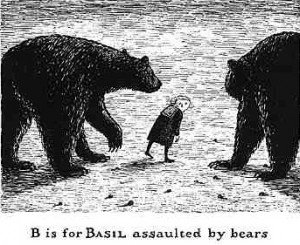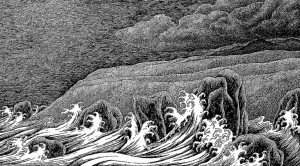I picked up a copy of The Dong With a Luminous Nose by Edward Lear for the title. It was wrapped in cellophane, so what lay between the covers was a mystery. I knew the illustrations would be good, because Edward Gorey is always good, but I was dead curious about what Lear was getting at with this peculiar title. Was it a book about Vietnamese currency? Would the words ‘Long’ and ‘Silver’ also appear? Nah. Too twentieth century. Turns out, the Dong is just a dong…not a name or an appendage, just the Dong. Like, the Dude, I suppose, or the Donald. As for his luminous nose, well, I’ll explain later.
Edward Gorey illustrated The Dong With a Luminous Nose in 1967, but this lovely little edition
was published just a few months ago by Pomegranate Press, who have been faithfully reissuing Gorey’s books for several years now. The Dong, in Lear’s story, pines for his ‘Jumbly Girl’ who has sailed away in a sieve with her fellow Jumblie troubadours, leaving the poor Dong high and dry. In an entirely reasonable response to his grief, the Dong builds a large, detachable nose out of the bark of a Twangum Tree, pimps it out with red paint and an internal light source, and spends the rest of his days roaming the great Gromboolian plain, ‘while he ever seeks, but seeks in vain, to meet his Jumbly Girl again.” Sad, really.
The famous literary critic, Edmund Wilson, called Gorey’s work ‘poetic and poisoned’ in a review in the New Yorker in 1959. Although Wilson was not specifically referring to The Dong with a Luminous Nose, the words ‘poetic’ and ‘poisoned’ perfectly capture the Gorey experience.
The Hiroshigesque scene in the opening of this story has a menacing feel. It’s as if the boulders are actually hooded wraiths and the waves don’t crash so much as claw at the shore. Nevertheless, it’s a beautiful illustration, and as always the quirky little creatures, human and otherwise, who populate Gorey’s illustrations in this book, and in fact, all of his books, help to lighten what is often a melancholic atmosphere.
 If droopy Dongs are not your bag, you may want to check out Gorey’s most infamous work, The Gashlycrumb Tinies. I have a poster in my bedroom featuring all 26 panels, starting with ‘A is for Amy who fell down the stairs.’ If you value irreverence, stunning pen & ink work, and subversive humour at the expense of children, this is your book. If you happen to be suffering from an advanced case of Munchausen by Proxy, and you’re running out of ideas, look no further. The Gashlycrumb Tinies is the most delightful treatise on childhood since Jonathan Swift’s A Modest Proposal.
If droopy Dongs are not your bag, you may want to check out Gorey’s most infamous work, The Gashlycrumb Tinies. I have a poster in my bedroom featuring all 26 panels, starting with ‘A is for Amy who fell down the stairs.’ If you value irreverence, stunning pen & ink work, and subversive humour at the expense of children, this is your book. If you happen to be suffering from an advanced case of Munchausen by Proxy, and you’re running out of ideas, look no further. The Gashlycrumb Tinies is the most delightful treatise on childhood since Jonathan Swift’s A Modest Proposal.
The Doubtful Guest is another twisted tale from the exceptionally nonsensical brain of Edward Gorey. The guest in question is…oh I don’t know…a seal-like creature in sneakers who shows up uninvited to a house and proceeds to wreak havoc upon the members of the household. I’m no psychiatrist, but I would say that this guest is exhibiting clear signs of obsessive compulsive disorder.
A typical Thanksgiving weekend in my family, yes, but this fellow stays for 17 years, and by the end of the book, no one is any wiser. Bewilderment is a common theme in Gorey’s books, but he was unrepentant about his dark subject matter:
“If you’re doing nonsense it has to be rather awful, because there’d be no point. I’m trying to think if there’s sunny nonsense. Sunny, funny nonsense for children — oh, how boring, boring, boring. As Schubert said, there is no happy music. And that’s true, there really isn’t. And there’s probably no happy nonsense, either.”
I’m sorry, Mr Gorey. I have to disagree. Your books are nothing but happy, beautiful, nonsense.
The Dong With a Luminous Nose by Edward Lear, drawings by Edward Gorey Pomegranate 2010
Gashlycrumb Tinies by Edward Gorey Houghton Mifflin Harcourt, reissued 1999
Doubtful Guest by Edward Gorey Harcourt Brace & Co, 1985
A Modest Proposal by Jonathan Swift, 1729
Please check out Gorey Details. It’s a fabulous site for all your Gorey Needs






Best title ever!!